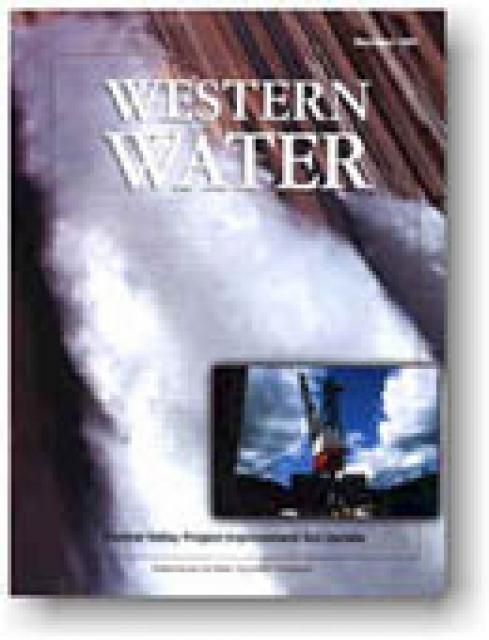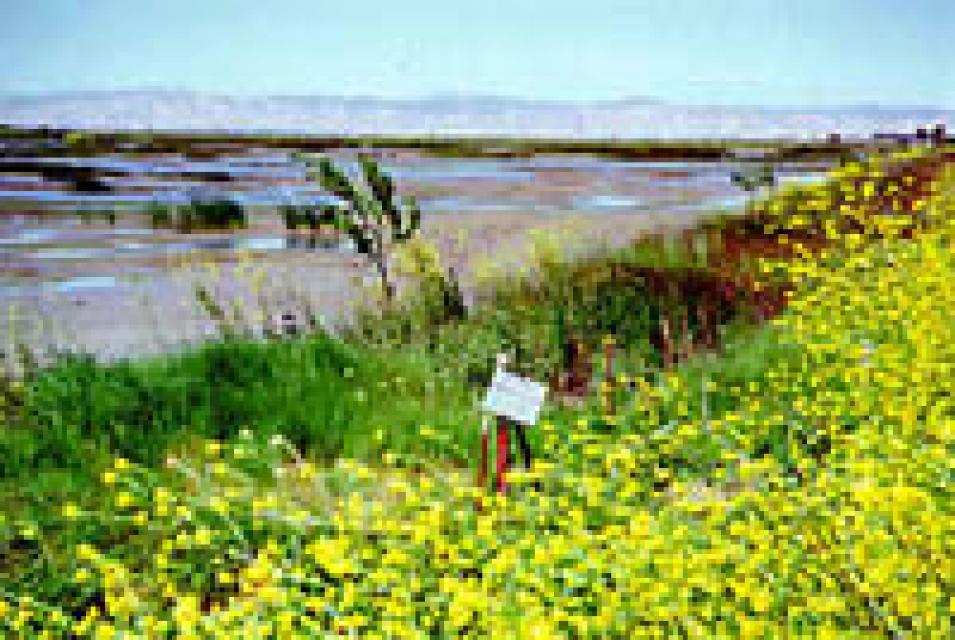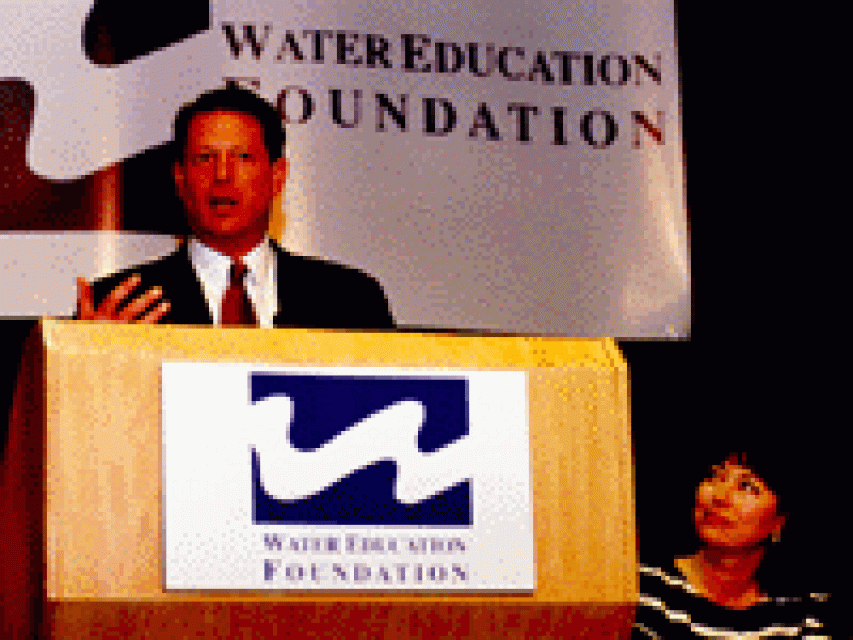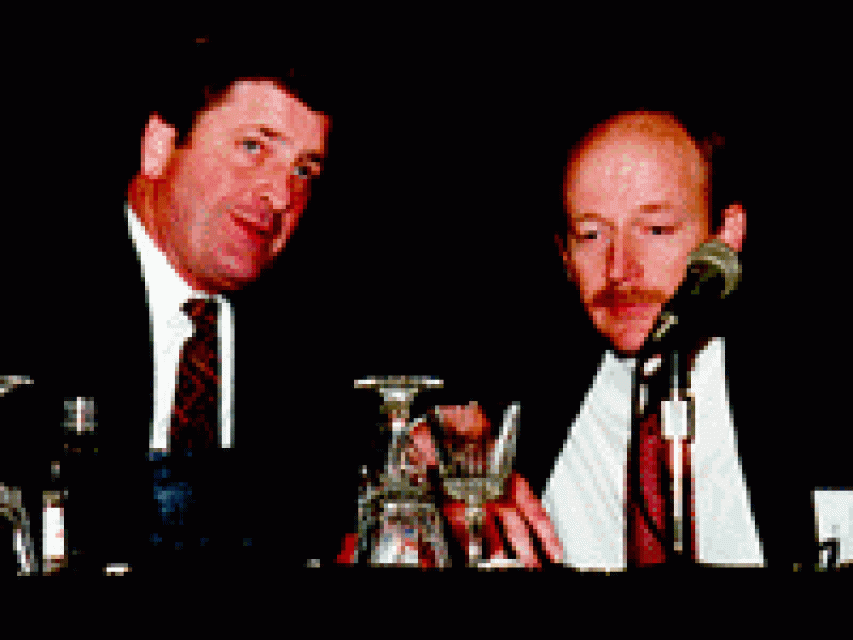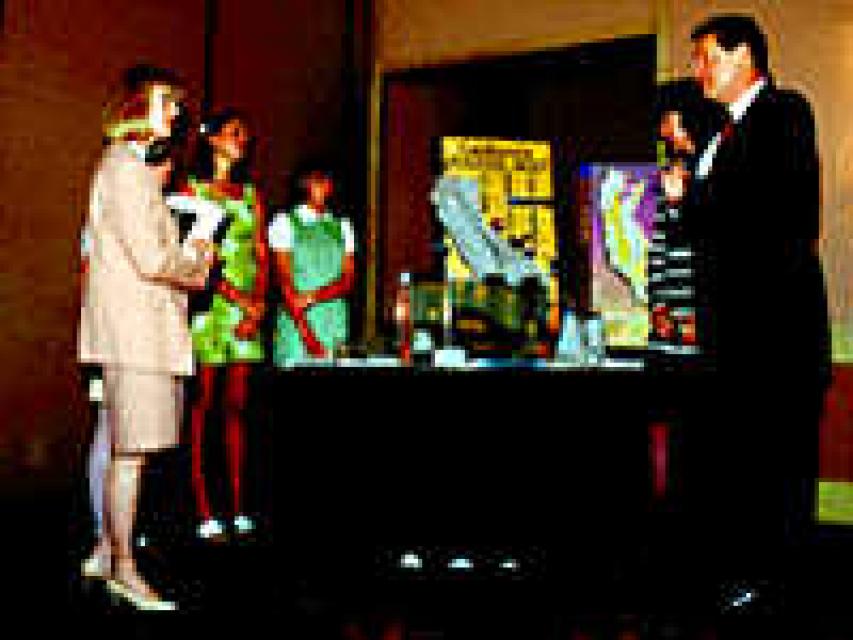CVP Improvement Act Update
May/Jun 1997
Editor’s Desk
Two days before our annual Executive Briefing, I picked up my phone to hear “The White House calling… .” Vice President Al Gore had accepted the foundation’s invitation to speak at our March 13 briefing on California water issues. That was the start of a new experience for us. For in addition to conducting a briefing for about 250 people, we were now dealing with Secret Service agents, bomb sniffing dogs and government sharpshooters, speech writers, print and TV reporters, school children and public relations people.
All the confusion was forgotten when the Vice President arrived the afternoon of our briefing after his speech to a joint session of the state Legislature. Mr. Gore was gracious and seemed genuinely interested in our work. While the Vice President finished some work back stage, Valerie Holcomb and I stalled for time by discussing our programs. Finally I was signaled that the Vice President was ready to speak. A newspaper column headline “Gore recalls his presidency” the next day reflected the story I told the audience.
I noted that Mr. Gore had been sworn in five minutes before Bill Clinton in January, and thus technically was a former president, according to some dubious historians. Gore responded, “Historians will record that during the Gore administration, our country was at peace at home and abroad. We had a booming economy with low inflation. We created 3.1 jobs, 1.2 of them here in California… By the end of the term, you could almost hear the chant, starting in California and sweeping eastward across the nation: Five more minutes. Five more minutes.”
The Foundation staff and supporters appreciated Gore’s remarks about our 20 years of educating the public on water issues and bringing decision-makers together. After his speech, which also discussed the federal role and financial assistance in the CALFED process, Mr. Gore participated in a demonstration of the groundwater model.
With the briefing over, it was back to the office to work on this latest issue of Western Water — about the controversial CVPIA. An update of this topic was overdue. We focused on several key provisions. The heated discussion by the stakeholders over how to use the law’s annually dedicated 800,000 acre-feet of water for the environment, the Anadromous Fish Restoration Program to meet the requirement to double natural migrating fish populations in Central Valley streams and the long-awaited Programmatic Environmental Impact Statement. With the Bureau of Reclamation’s recent reduction of water to CVP contractors, the issue is timely and hotter than ever. We hope this magazine will help you understand what’s happening.
Elizabeth “Lizzy” McCarthy, who formerly covered water issues at the Bureau of National Affairs, wrote this CVPIA update with the assistance of Sue McClurg, who is now working on her final Sacramento-San Joaquin River Basin report for the Western Water Policy Review Advisory Commission.
CVP Improvement Act Update
by Elizabeth McCarthy
Four years after it was enacted, controversy over the federal Central Valley Project Improvement Act (CVPIA) continues. Several key sections of the CVPIA have yet to be implemented because of their scope and complexity, disputes over interpretation and implementation — including a lawsuit and attempted legislative changes by CVP irrigators — as well as an administrative effort to address conflicts.
“The act is properly being implemented though probably at a slower pace than I might have hoped for several years ago,” Rep. George Miller (D-Pleasant Hill), co-author of the act, said at a March 20 congressional oversight hearing on the CVPIA. “We didn’t anticipate the immediate legal challenges to the law, and we may have underestimated the scientific complexities of some of the restoration goals.”
Passed in October 1992, the CVPIA (Public Law 102-575) fundamentally changed operation of the Central Valley Project, which supplies 20 percent of the state’s developed water, by putting environmental protection and restoration on equal footing with irrigation and urban water supply demands to benefit the Central Valley’s aquatic ecosystem and wetlands.
Since the act’s passage, numerous environmental restoration measures have been executed. These include modification of CVP operations, management of water dedicated to the environment, increased water deliveries to wildlife refuges, installation of fish screens on water diversions, and an $80 million temperature control device at Shasta Dam to aid Sacramento River salmon. More than $100 million has been spent on environmental rehabilitation projects. In addition, water conservation criteria for CVP contractors and proposals for land retirement in areas of the San Joaquin Valley with agricultural drainage problems have been developed. While the Department of Interior (Interior) has moved forward with several CVPIA programs, it has continued to work closely with stakeholders and the interested public to identify the best ways to implement other provisions of the CVPIA, Interior Deputy Secretary John Garamendi said at the congressional oversight hearing.
Major sections of the CVPIA still being debated include management of 800,000 acre-feet of CVP yield for the environment, the Anadromous Fish Restoration Program (AFRP) plan to double natural populations of migrating fish in Central Valley streams and the Programmatic Environmental Impact Statement (PEIS), which looks at the impacts of alternatives for implementing the law.
There also are disputes over changes made to CVP water supply contracts, including the requisite extensive PEIS prior to long-term renewals, a reduction in the duration of the contracts from 40 years to 25 years, an increase in the cost of delivered water and imposition of restoration fund fees. Earlier this year, a federal court invalidated the Bureau’s long-term renewals of 14 Friant Division water contracts, which were renewed for an additional 40-year period prior to passage of the CVPIA. The judgment was modified April 16 to allow the contracts to remain in effect until March 1998, so that the Bureau can continue to deliver water and allow for completion of the PEIS.
The PEIS was due October 1995, but the draft PEIS won’t be released until this June. Until it is finalized, rules and regulations implementing the CVPIA and the long-term contracts cannot go forward. The U.S. Fish and Wildlife Service’s (USFWS) fish-doubling plan was due October 1995 and was expected to be released as this issue of Western Water went to press.
As with many aspects of the law, the reasons for the missed deadlines are a matter of dispute. Agricultural interests attribute the delay to a lack of federal agency leadership.
In 1994, Westlands Water District filed a lawsuit, which was dismissed, contending the Bureau was required to carry out an environmental impact assessment prior to carrying out certain CVPIA provisions, including the management of 800,000 acre-feet of CVP yield. Some CVP irrigators also attempted a legislative overhaul of the act in 1995 (HR 2738), introduced by Rep. John Doolittle, R-Rocklin, to lessen what they say are the act’s punitive and disproportionate impacts on agricultural contractors.
“The CVP contractors who use about 20 percent of the state’s developed water are singled-out in the CVPIA to take on some extremely tough environmental objectives,” said Dan Nelson, general manager of the San Luis & Delta-Mendota Water Authority. “Environmental restoration should be addressed on a statewide basis.”
Environmentalists, on the other hand, say the lawsuit and attempted legislative overhaul by some CVP irrigators has delayed implementation of ecosystem restoration measures mandated by the CVPIA.
“We keep sliding farther and farther away from meaningful implementation, and each step backslides on water for the environment,” said David Yardas, senior analyst at the Environmental Defense Fund (EDF).
For CVP contractors, the delays and associated water supply reliability questions prevent them from making informed decisions about contract renewals and farming operations.
The most contested issue, not surprisingly, is the annual dedication of CVP yield for the benefit of Central Valley fisheries, wildlife and habitat. To date, a long-term management study and accounting plan for the dedicated yield has not been completed. The heart of the debate is over the amount of CVP yield used in the Delta — water that cannot be recaptured and exported. Specifically, how much — if any — of the 800,000 acre-feet of CVP yield can exceed outflow levels set by the State Water Resources Control Board (State Board) following the consensus-led December 1994 Bay-Delta Accord. The Bay-Delta stakeholders agreed that approximately 400,000 acre-feet to as much as 1.1 million acre-feet of combined increased CVP and State Water Project (SWP) flow would be sent out the Delta.
On April 17, the Bureau released a revised 1997 water allocation plan because of the unusual dry spell following the New Year’s floods. The forecast reduces water deliveries to CVP agricultural contractors to 90 percent and partially meets the USFWS’s recommended flow-related habitat actions. The plan estimates sending 263,000 acre-feet of CVP yield to the Delta to meet the CVP’s share of the accord’s standards and using 280,000 acre-feet of the yield upstream. Whether any of the remaining 247,000 acre-feet of environmental water, which is over the accord’s obligations, will also be used in the Delta is under debate.
Some say disputes over implementation of the key CVPIA provisions could be more protracted than the decades-long war over water quality standards and water rights in the Bay-Delta.
“We are trying to find agreement on the dedication of 800,000 acre-feet to keep the whole thing from blowing up,” said Greg Gartrell, director of planning for the Contra Costa Water District (CCWD).
The debate over dedication of CVP yield as well as the AFRP proposals focuses on the scientific process and scientific basis underlying increased flows. Most agree that the impact of these provisions will be felt most keenly by farmers in drought years. Until the scientific gaps are filled, at issue is who gets the benefit of the scientific doubt when there is not enough water to satisfy both needs, the irrigators or the ecosystem. “Which side do we err on?” asked Roger Patterson, director of the Bureau’s Mid-Pacific Region.
A critical factor in CVPIA implementation is its linkage with the CALFED Bay-Delta process. The Bureau and USFWS, which are both in Interior, are jointly responsible for implementing the CVPIA and are part of the CALFED coalition. “Interior’s objective is to put into place operating procedures for the CVPIA that allows everyone to know what to expect from CVP operations while focusing on the long term CALFED/Bay-Delta efforts,” said USFWS Assistant Regional Director Dale Hall.
This issue of Western Water examines key CVPIA debates including those over management of CVP yield, the anadromous fish doubling plan, and CVP contract renewals. For more information on the CVP, please refer to the Foundation’s Layperson’s Guide to the Central Valley Project.
Executive Briefing Recap
Vice President Al Gore spoke at the Foundation’s 14th annual Executive Briefing, Crisis, Conflict and Cooperation in Water, held March 13 in Sacramento. Gore spoke about the importance of environmental education and the federal-state partnership’s actions to protect and restore the Bay-Delta. He applauded the Foundation’s work to promote greater understanding of Western water issues.
More than 200 people attended the briefing, which focused on three critical topics — the New Year’s flooding, the controversy over California’s allocation of Colorado River water and the CALFED Bay-Delta Program.
Deputy Interior Secretary John Garamendi, left, spoke about California’s Colorado River entitlement. Lester Snow, CALFED Bay-Delta Program Executive Director, provided a Bay-Delta update.
John Garamendi, deputy secretary of the Department of Interior, urged stakeholders to strive towards a common solution to live within California’s annual 4.4 million acre-feet entitlement of Colorado River water. Interior Secretary Bruce Babbitt is pushing California to stay within its entitlement and to develop a conservation plan to ensure that the state does not divert more than its allotted share of water.
Lester Snow, manager of the CALFED Bay-Delta Program, spoke about the impact of the 1997 floods and how improved flood management could go hand-in-hand with long-term ecosystem restoration and water supply reliability. He stressed the importance of continued diverse stakeholder involvement and commitment to finding a balanced alternative. Proceeds from the event benefit the Foundation’s school programs.
After his speech, Mr. Gore viewed the Foundation’s groundwater model.





